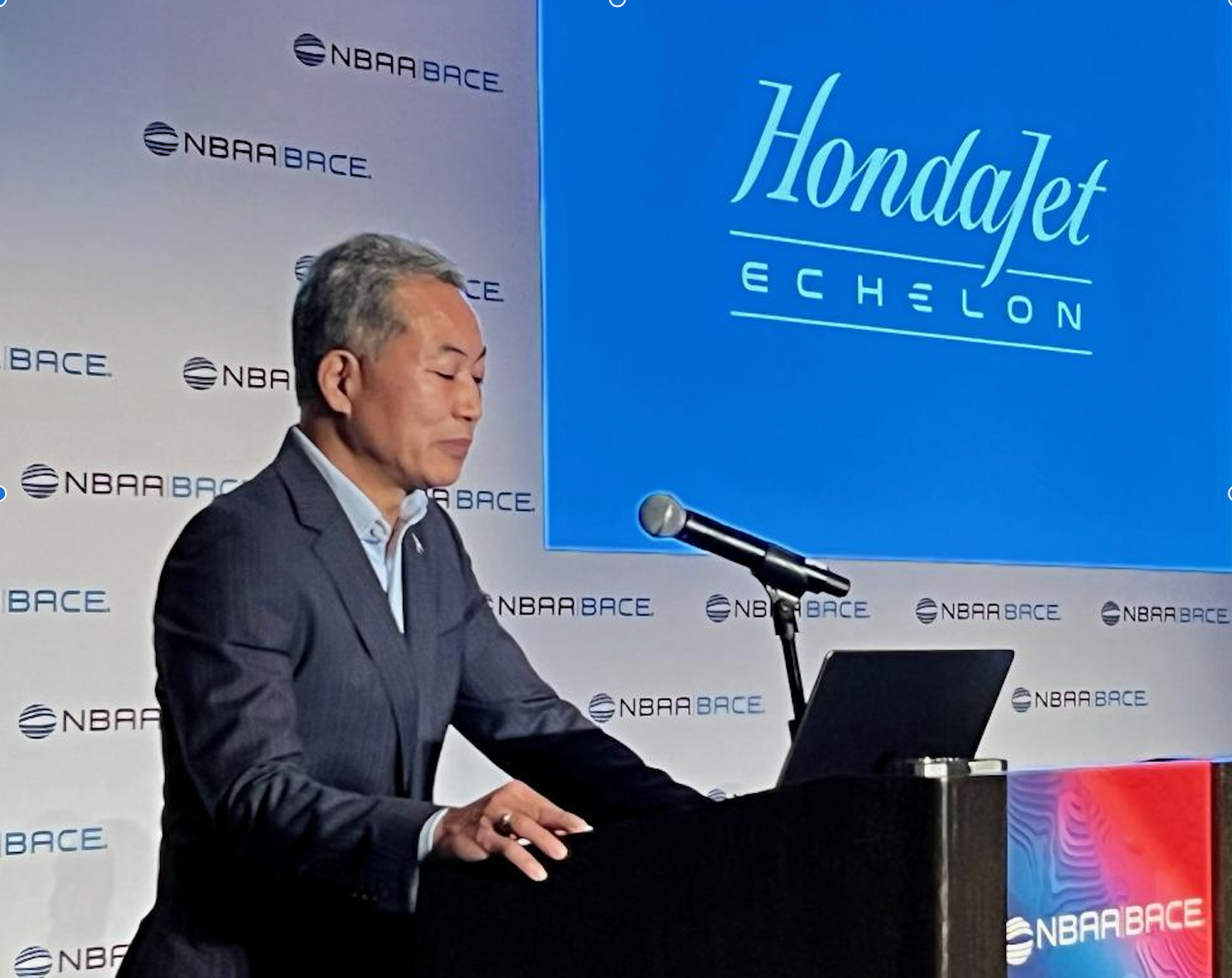Honda Reveals Next Expression of the HondaJet Series with Echelon
The HondaJet Echelon transcontinental light jet project was introduced at NBAA-BACE 2021, and HACI pursues a common type rating with the Elite II.

Honda Aircraft Company president and CEO Hideto Yamasaki presented the HondaJet Echelon at NBAA-BACE 2023. [Credit: Stephen Yeates]
With a bit of fanfare this morning at the National Business Aviation Association’s Business Aviation Conference & Expo in Las Vegas, Honda Aircraft Company pulled the curtain on the official marketing name for its new light jet. What was unveiled at BACE in 2021 as the HondaJet 2600 concept shall now be known as the HondaJet Echelon. The naming firmly establishes the next jet in the company’s lineup—and play to move up the scale.
The promise? To take the light jet category up a notch, and attempt to translate a “midsize jet experience” to a smaller platform—one capable of transcontinental U.S. trips. In doing so, Honda Aircraft anticipates an increase in mission flexibility for owner-pilots while keeping operating costs—and fuel burn—in check. The proposed design may attain up to 20 percent increased fuel efficiency over other light jets and up to 40 percent over midsize jets with which it expects to compete.
In the cabin, the midsize feel would continue, with “a holistic focus on the cabin experience encompassing space, comfort, and productivity,” according to the company.
“The HondaJet Echelon was born to create a new category that transcends the travel experience on conventional light jets,” said Hideto Yamasaki, president and CEO of Honda Aircraft Company, in a preview statement. “Expanding mobility skyward has been Honda’s long-lasting dream, and the HondaJet Echelon marks the exciting next chapter while showcasing a classic Honda story of a product that creates new value for people.”
Common Type Pursuit
One key element to the new model, designated the HA-480 within the HondaJet family, is Honda Aircraft's pursuit of a common type rating to the Elite II's basis, the HA-420. The bid will be made possible by the use of the Garmin G3000 flight deck architecture, along with flight control response and feel, and single-pilot operation in parallel. On the production line, which will run alongside that of the Elite II, Honda Aircraft is targeting as much parts commonality as possible given the change in fuselage and cross section.
Yes, the Echelon will be a bigger jet, however, with an estimated wingspan of 56 feet, length of 57 feet, and tail height of 16 feet, plus a maximum takeoff weight of 17,500 pounds.
Amod Kelkar, chief commercial officer for Honda Aircraft, has been named the program manager on the HondaJet Echelon, a project he has been deeply involved with since joining the company as vice president of customer support in 2021. In an interview with FLYING, Kelkar indicated that the Echelon makes a play for changing the blend of customers for the HondaJet series. "We have, effectively, three types of customers," said Kelkar.
"The first one is the owner-operator who are also pilots, so they have their own aircraft, they fly their own aircraft, using it for personal [trips] or for business. Their utilization is in the zone of 150 hours per year. Then we have...corporate customers, not necessarily corporations. Those have a bit higher utilization, I would say, around 250 to 400 hours a year per aircraft, and they fly strictly for B2B type of visits. And then the third segment is in terms of utilization is the highest, but in terms of numbers is the smallest, is the charter and fractional ownership," which files roughly 1,400 to 1,500 hours per year.
While 85 percent of current customers are in the first two segments, the Echelon is deemed likely to appeal to the Part 135 and Part 91K operators that can leverage its range to suit New York to Florida or Caribbean destinations with seats full.
HondaJet Echelon Milestones
While the name marks an important step in the process to bringing a new aircraft into the product line, other key milestones have recently been achieved by the OEM.
First, the company installed the first structural test rig in the fourth quarter of 2021, not long after the program was officially announced. Since then, the manufacturer has exited the concept phase and competed its preliminary design review, which fixes in place critical markers within the program.
Also, Honda Aircraft celebrated the official power-on ceremony for the Echelon’s advanced systems integration test facility (ASITF) at the company’s Greensboro, North Carolina, headquarters on August 30, 2023.
Honda Aircraft targets the next aircraft level critical design review in the summer of 2024, with “select long lead fabrication already in progress,” according to a statement from the company. The OEM will produce the Echelon within the company’s current footprint at Greensboro, with early build processes to begin in 2024.
First flight is projected for 2026, with type certification targeted for 2028.
Sustainability Efforts
Honda Aircraft also has taken its place in the race to more efficiency with its participation in the 2023 NBAA-BACE Sustainability Pledge, “demonstrating a commitment to make NBAA-BACE a more eco-friendly event,” according to the company. “In addition, Honda Aircraft Company is utilizing the Sustainable Aviation Fuel Book and Claim [SAFC] Program for its ferry flights to and from NBAA-BACE to promote the deployment of SAF and support the industry's commitment to carbon neutrality.”
HondaJet Specs
Engines: Williams International FJ44-4C
Avionics: Garmin G3000
Configuration: 1 crew + 10 pax or 2 crew + 9 pax
NBAA IFR Range: (1 crew + 4 pax)* 2,625 nm
Maximum Cruise Speed*: 450 ktas
Maximum Cruise Altitude*: FL470

Subscribe to Our Newsletter
Get the latest FLYING stories delivered directly to your inbox






